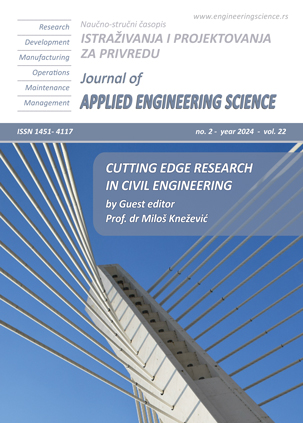THE FLEXURAL BEHAVIOR OF SUSTAINABLE LIGHTWEIGHT CONCRETE HOLLOW CORE SLABS
Abstract
Hollow slabs are reinforced concrete slabs with voids that enable less concrete to be used. To promote sustainability goals, this type of slab reduces material use and enhances insulating characteristics. This paper presents an experimental program for studying the flexural behavior of the sustainable hollow Slab elements of lightweight concrete with three different ratios of mixes using additives to choose the best ratio, which is then compared to a solid model with the same concrete mix with the best characteristics to clarify the variations in the structural behavior of voided slabs. In this investigation, hollow slabs with circular plastic tubes of 50mm diameter and 1020 mm length were used, organized as continuous voids with 30 mm spacing between the tubes. Three slabs were created, each measuring 1020 mm long, 420 mm wide, and 100 mm thick. All three slabs were tested via four-point loading. The best mix ratio was chosen and used to build a robust model. To analyse the key advantages of this technology over typical solid slabs, this solid model was compared to the best-performing model among the three hollow core slabs. Several properties such as load-carrying capability, deflection, crack patterns, and failure modes were observed in all loading steps. The results showed that using uniformly distributed uniaxial voids in the slab reduced concrete use by 23% as compared to solid slabs, Notably, the specimen with 200 kg/m3 lightweight aggregate demonstrated greater crack distribution and crack breadth.
References
Chung, J.H., Choi, H.K., Lee, S.C. and Choi, C.S. Flexural capacities of two-way hollow slab with donut type void. Proceeding of annual conference of the architectural institute of Korea, 2018; 9-20.
Ryan, E.M.; Sanquist T.F. Validation of building energy modelling tools under idealized and realistic conditions, Energy Buildings, 2011;47, 375-382.
Domínguez, S.; Sendra J.; León A.; Esquivias P. Towards energy demand reduction in social housing buildings: Envelope system optimization strategies. Energies, 2012; 5 (7): 2263-2287.
Al-Homoud, M.S. Performance characteristics and practical applications of common building thermal insulation materials. Building and environment, 2005; 40(3), 353-366.
Robinson, A.; Lesage F.; Reilly A.; Mc Granaghan G.; Byrne G.; O’Hegarty R.; Kinnane O. A new transient method for determining thermal properties of wall sections, Energy Buildings, 2017; 142, 139- 146.
Gervásio, H.; Santos P.; da Silva L.S.; Lopes A. Influence of thermal insulation on the energy balance for cold-formed buildings. Advanced steel construction, 2010; 6(2), 742-766
Marais, C., Design adjustment factors and the economical applications of concrete flat-slabs with internal spherical voids in south africa, M.Sc. Thesis, University of Pretoria, August 2009.
Mutashar, S. H., Flexural behaviour of sustainable reactive powder concrete voided slabs, M.Sc. Thesis, Mustansiriayah University, May 2017.
Mahdi A. A. and Ismael, M.A., Structural behaviour of hollow core reinforced self-compacting concrete one way slabs, Conference Series: Materials Science and Engineering (iopscience.iop.org), 2020.
ACI 213R-87, Guide for structural lightweight aggregate concrete, Detroit, Michigan, 1999.
Newman, J., Choo, B. S. and Owens, P., Advanced concrete technology processes, Elsevier Ltd., 2003.
Junaid, M. F., Rehman, Z. ur, Kuruc, M., Medveď, I., Bačinskas, D., Čurpek, J., Čekon, M., Ijaz, N., & Ansari, W. S. (2022). Lightweight concrete from a perspective of sustainable reuse of waste byproducts. Construction and Building Materials, 319(September 2021). https://doi.org/10.1016/j.conbuildmat.2021.126061
Neville, A.M. and Brooks, J.J., Concrete technology, second edition, Prentice Hall, Pearson Education, 2010.
Junaid, M. F., Rehman, Z. ur, Kuruc, M., Medveď, I., Bačinskas, D., Čurpek, J., Čekon, M., Ijaz, N., & Ansari, W. S. (2022). Lightweight concrete from a perspective of sustainable reuse of waste byproducts. Construction and Building Materials, 319(November 2021). https://doi.org/10.1016/j.conbuildmat.2021.126061.
Adhikary, S. K., & Rudzionis, Z. (2020). Influence of expanded glass aggregate size, aerogel and binding materials volume on the properties of lightweight concrete. Materials Today: Proceedings, 32, 712–718. https://doi.org/10.1016/j.matpr.2020.03.323
Abdulhussein, S., & Alfeehan, A. (2021). MECHANICAL PROPERTIES OF STRUCTURAL AERATED LIGHTWEIGHT CONCRETE REINFORCED WITH IRON LATHING WASTE. Journal of Engineering and Sustainable Development, 25. https://doi.org/10.1061/jsdeag.0003070.
Zamzani, N. M., Mydin, A. O., & Abdul Ghani, A. N. (2018). Experimental investigation on engineering properties of lightweight foamed concrete (LFC) with coconut fiber addition. MATEC Web of Conferences, 250, 1–8. https://doi.org/10.1051/matecconf/201825005005
Thakur, A., & Kumar, S. (2022). Mechanical properties and development of light weight concrete by using autoclaved aerated concrete (AAC) with aluminum powder. Materials Today: Proceedings, 56, 3734–3739. https://doi.org/10.1016/j.matpr.2021.12.508.
A. Khan, M. Baluch, and A. Al-Gadhib, Repair and strengthening of reinforced concrete structures using CFRP plates, in Proceedings of international Bhurban conference on applied sciences and technology, 2004; 26 (2), Pakistan.
ACI 318-14, Building code requirements for structural concrete, in American concrete institute, 2014.
BS 1881-Part 116-2000, Method for determination of compressive strength of concrete cubes, British standards institute BSI, London, 2000.
ASTM C496-04 "Standard test method for splitting tensile strength of cylindrical concrete specimens, Annual book of american society for testing and material standards, Concrete and aggregate, West Conshohocken, PA, United States, 4 (2), 2004.
ASTM C78, Standard test method for flexural strength of concrete using simple beam with two points loading, Annual Book of ASTM standard, 4 (2), 2002.
ASTM C469, Standard test method for static modulus of elasticity and poisson’s ratio of concrete in compression, 2002 of wall sections, Energy Buildings, 2017; 142, 139- 146.

